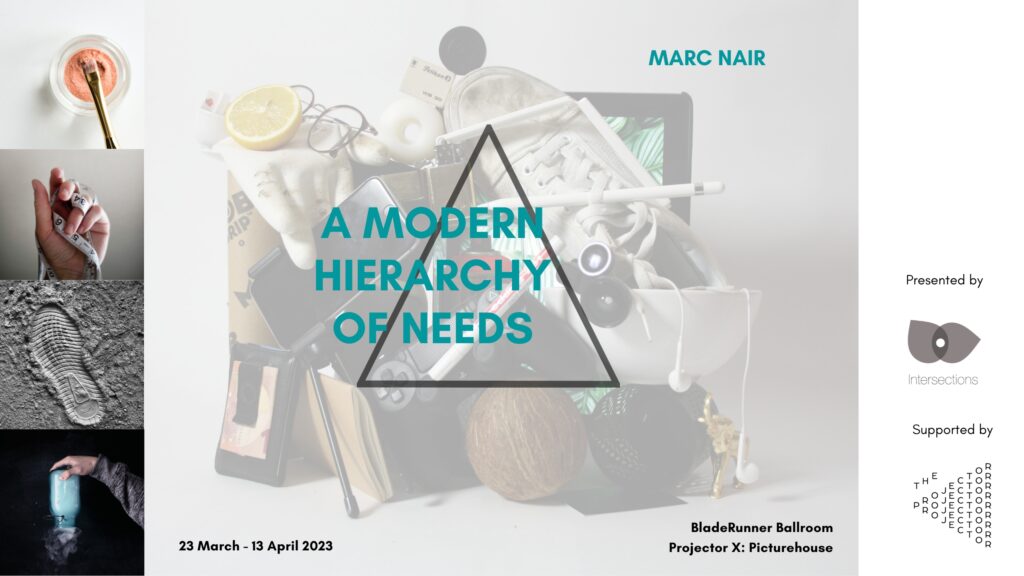
In many ways, humanity’s basic needs have not changed for centuries. Survival is still paramount for large swathes of the population, while it is only a minority who can think about higher order wants. But it is also worth noting how the necessities no longer solely encompass food, shelter, water, and sanitation. There is access to the digital world, material and immaterial desires and longer arcs of thought about the future that, arguably, affect everybody.
The classic pyramid that Abraham Maslow envisioned is now filled with other things, things that consume us in ways that terrify us if we stepped back from ourselves to consider how and why we prioritise citadels of the self against the vaster city of time we live in. The urge for the new is the distaste for the old. Anything acquired becomes obsolete. We purchase and immediately set forth on the next conquest.
The text in A Modern Hierarchy of Needs apprehends the pyramid with new eyes and populates it with a different way of being. But the pyramid is also the precursor to a mode of thinking about art making. I have noticed a tendency in my own creative practice to utilise an adaptive reuse of ideas. Adaptive reuse is a broad, interdisciplinary concept that is usually connected with significant changes resulting from conversion to a new function (Remøy & Van der Voordt, 2014). Adaptive reuse as design practice in architecture is often seen in the way churches, power plants and other abandoned or disused buildings are refurbished and adapted to become art galleries, performance spaces or museums (Pieczka & Bogusław, 2021).
If we extend this to thinking about artistic ideas, what could it possibly look like?
The origins of A Modern Hierarchy of Needs began as a casual conversation in Hong Kong in 2016. At the opening of an art gallery, I met Sudhee Liao, a choreographer and dancer from Singapore. We found common thematic strands in our work and expressed an interest to develop a collaboration. This slowly took shape over the next two years and eventually settled on a series of movements that responded to text. The process was iterative, and the final product was a short film comprising ten vignettes, filmed in various locations in Hong Kong in 2019. That film was called Handbook of Daily Movement.
In 2020, commissioned by The Arts House in Singapore for Textures, a literary festival, we adapted the film for the stage, working with Mantravine, a musician, and three other dancers to realise a fuller production of text, movement, and music. To layer ideas of eco-fragility and push back against wasteful consumption, some of the costumes used for the production were created by set designer Audrey Ng out of kombucha. We also published a zine containing the text of all the pieces.
The current exhibition keeps the text as the fulcrum of meaning but adapts it once again for the screen, this time with a collage of images as the background. The ephemeral nature of the text coupled with how it loops becomes an objectified exemplar of how an idea becomes embodied in different ways, from movement and narration to a performative expression and back to the screen as moving text. This process was not intentional. There was no grand creative arc of production. The work morphed and shifted through chance encounters, conversations, and opportunities.
A Modern Hierarchy of Needs screens on ten screens that typically display movie posters but have been adapted to play video. The exhibition, presented by Intersections Gallery, is held in the nostalgically named BladeRunner Ballroom, a circular space in The Projector X: Picturehouse. This is a pop-up initiative of The Projector. Taking over the empty cinemas of Cathay Cineplex, the Projector X is itself a temporary intervention. In a city where land scarcity necessitates constant renewal and the optimal use of space, it is unsurprising that ideas, too, should live on and gain new forms of being.
References
Pieczka, M. and Bogusław W. 2021. “Art in Post-Industrial Facilities—Strategies of Adaptive Reuse for Art Exhibition Function in Poland” Buildings 11, no. 10: 487.
Remøy, H. and Van der Voordt, T. 2014. “Adaptive reuse of office buildings into housing: Opportunities and risks”. Build. Res. Inf. 42, 381–390.
Exhibition Opening: 23 March 2023, 6.30pm
RSVP here: https://www.intersections.com.sg/amodernhierarchy-intersection-exhibition-268474.html
Artist Talk: 4 April 2023, 7pm.

